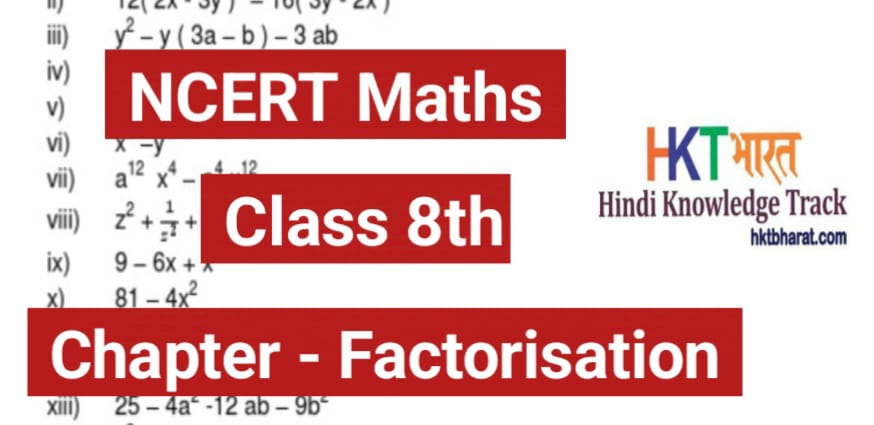NCERT Class 8th Maths Solutions Factorisation | NCERT Solutions for Class 8 Maths Chapter 12 – Factorisation
Chapter 12 Factorisation
Exercise – 12.2
- Factorise the following expressions.
(i) a2+8a+16
Solution –
a2+8a+16
Using the identity (a + b)2 = a2 + 2ab + b2
= a2+2×4×a+42
= (a+4)2
(ii) p2–10p+25
p2–10p+25
Using the identity (a + b)2 = a2 + 2ab + b2
= p2– 2×5×p+52
= (p -5)2
(iii) 25m2+30m+9
25m2+30m+9
Using the identity (a + b)2 = a2 + 2ab + b2
= (5m)2+2×5m×3+32
= (5m+3)2
(iv) 49y2+84yz+36z2
49y2+84yz+36z2
Using the identity (a + b)2 = a2 + 2ab + b2
=(7y)2+2×7y×6z+(6z)2
= (7y+6z)2
(v) 4x2–8x+4
4x2–8x+4
Using the identity (a + b)2 = a2 + 2ab + b2
= (2x)2-2×4x+22
= (2x-2)2
(vi) 121b2-88bc+16c2
121b2-88bc+16c2
Using the identity (a + b)2 = a2 + 2ab + b2
= (11b)2-2×11b×4c+(4c)2
= (11b-4c)2
(vii) (l+m)2-4lm (Hint: Expand (l+m)2 first)
Expand (l+m)2 using the identity- (a + b)2 = a2 + 2ab + b2
(l+m)2-4lm = l2+m2+2lm-4lm
= l2+m2-2lm
= (l-m)2
(viii) a4+2a2b2+b4
a4+2a2b2+b4
Using the identity (a + b)2 = a2 + 2ab + b2
= (a2)2+2×a2×b2+(b2)2
= (a2+b2)2
2. Factorise.
(i) 4p2–9q2
4p2–9q2
a2 – b2 = (a – b) (a + b)
Using the identity a2 – b2 = (a – b) (a + b)
= (2p – 3q)( 2p + 3q)
(ii) 63a2–112b2
63a2–112b2
= 7(9a2 –16b2)
Using the identity a2 – b2 = (a – b) (a + b)
= 7((3a)2–(4b)2)
= 7 (3a + 4b) (3a – 4b)
(iii) 49x2–36
49x2–36
Using the identity a2 – b2 = (a – b) (a + b)
= (7x)2 – 62
= (7x + 6)(7x – 6)
(iv) 16x5–144x3
16x5–144x3
= 16x3(x2– 9)
= 16x3(x2– 9)
Using the identity a2 – b2 = (a – b) (a + b)
= 16x3(x2– 32 )
= 16x3(x – 3)(x + 3)
(v) (l+m) 2– (l – m) 2
(l+m) 2– (l – m) 2
Using the identity a2 – b2 = (a – b) (a + b)
= {(l+m) – (l–m)} {(l +m) + (l–m)}
= (l+m–l+m)(l+m+l–m)
= (2m)(2l)
= 4 ml
(vi) 9x2y2–16
9x2y2–16
Using the identity a2 – b2 = (a – b) (a + b)
= (3xy)2– 42
= (3xy – 4) (3xy + 4)
(vii) ( x2–2xy+y2 ) – z2
( x2–2xy+y2 ) – z2
Using the identity (a – b)2 = a2 – 2ab + b2
= (x–y)2–z2
= (x–y)2–z2
Using the identity a2 – b2 = (a – b) (a + b)
= {(x–y) –z}{(x–y) + z}
= (x–y–z) (x–y+z)
(viii) 25a2–4b2+28bc–49c2
= 25a2– (4b2– 28bc + 49c2 )
= (5a)2– {(2b)2– 2(2b)(7c) + (7c)2} Using the identity (a – b)2 = a2 – 2ab + b2
= (5a)2– (2b – 7c)2
Using the identity a2 – b2 = (a – b) (a + b)
= (5a+2b-7c)(5a-2b+7c)
3. Factorise the expressions.
(i) ax2+bx
ax2+bx
= x(ax+b)
(ii) 7p2+21q2
7p2+21q2
= 7(p2+3q2)
(iii) 2x3+2xy2+2xz2
2x3+2xy2+2xz2
= 2x(x2+y2+z2)
(iv) am2+bm2+bn2+an2
am2+bm2+bn2+an2
= m2(a+b)+n2(a+b)
= (a+b)(m2+n2)
(v) (lm+l)+m+1
(lm+l)+m+1
= lm+m+l+1
= m(l+1)+(l+1)
= (m+1)(l+1)
(vi) y(y+z)+9(y+z)
y(y+z) + 9(y+z)
= (y+z)(y+9)
(vii) 5y2–20y–8z+2yz
5y2–20y–8z+2yz
= 5y(y–4)+2z(y–4)
= (y – 4)(5y + 2z)
(viii) 10ab+4a+5b+2
10ab+4a+5b+2
10ab + 5b + 4a+2
= 5b(2a+1)+2(2a+1)
= (2a+1)(5b+2)
(ix)6xy–4y+6–9x
6xy–4y+6–9x
= 6xy–9x–4y+6
= 3x(2y–3)–2(2y–3)
= (2y–3)(3x–2)
4.Factorise.
(i) a4–b4
a4–b4
= (a2)2 – (b2)2 Using the identity a2 – b2 = (a – b) (a + b)
= (a2– b2) (a2+ b2) Using the identity a2 – b2 = (a – b) (a + b)
= (a – b)(a + b)(a2+b2)
(ii) p4–81
p4–81
= (p2)2– (9)2 Using the identity a2 – b2 = (a – b) (a + b)
= (p2– 9)(p2+ 9)
= (p2– 32)(p2+ 9) Using the identity a2 – b2 = (a – b) (a + b)
=(p-3)(p+3)(p2+9)
(iii) x4– (y+z) 4
x4– (y+z) 4
= (x2)2 – [ (y+z)2 ]2 Using the identity a2 – b2 = (a – b) (a + b)
= {x2– (y+z)2}{ x2+(y+z)2}
= {(x – (y+z) (x+(y+z)}{x2+(y+z)2}
= (x–y–z)(x+y+z) {x2+(y+z)2}
(iv) x4–(x–z) 4
x4–(x–z) 4 Using the identity a2 – b2 = (a – b) (a + b)
= (x2)2-{(x-z)2}2
= {x2-(x-z)2}{x2+(x-z)2}
= { x-(x-z)}{x+(x-z)} {x2+(x-z)2}
= z (2x-z)( x2+x2-2xz+z2)
= z (2x-z)( 2x2-2xz+z2)
(v) a4–2a2b2+b4
a4–2a2b2+b4 Using the identity a2 – b2 = (a – b) (a + b)
= (a2)2-2a2b2+(b2)2
= (a2-b2)2
= ((a–b)(a+b))2
= (a – b)2 (a + b)2
5. Factorise the following expressions.
NOTE – इस प्रकार के सवालों में अंतिम पद की गुना प्रथम पद में मौजूद संख्या से करेंगे । अब जो भी परिणाम आएगा उसको गुना के रूप में इस प्रकार लिखेंगे , जिससे योग मध्यम पद की संख्या के बराबर आए।
(i) p2+6p+8
p2+6p+8
Note – यहाँ पर 8 की गुना 1 से करेंगे। 8 x 1
फिर 8 को गुना के रूप में इस प्रकार लिखेंगे जिससे कि उन संख्याओं का योग 6 आये
8 = 4 x 2
4 + 2 = 6
Note: Here we will multiply 8 by 1.
8 x 1
Then 8 will be written in the form of multiplication in such a way that the sum of those numbers becomes 6.
8 = 4 x 2
4 + 2 = 6
p2+6p+8 can be written as ( इसको ऐसे लिख सकते है ) p2+2p+4p+8
Taking Common terms, we get ( समान पद को कॉमन ले लेंगे )
p2+2p+4p+8
= p(p+2)+4(p+2)
Again, p+2 is common in both the terms. ( यहाँ भी p+2 समान पद को कॉमन ले लेंगे। )
= (p+2)(p+4)
(p+2)(p+4)
(ii) q2–10q+21
(ii) q2–10q+21
We observed that 21 = -7×-3 and -7+(-3) = -10
q2–10q+21 = q2–3q-7q+21
= q(q–3)–7(q–3)
= (q–7)(q–3)
(iii) p2+6p–16
p2+6p–16
We observed that -16 = – 2 × 8 and 8+(- 2) = 6
p2+6p–16
= p2–2p+8p–16
= p(p–2)+8(p–2)
= (p+8)(p–2)
= (p+8)(p–2)
NCERT Solutions for Class 9 Maths Chapter 6 Lines and Angles


